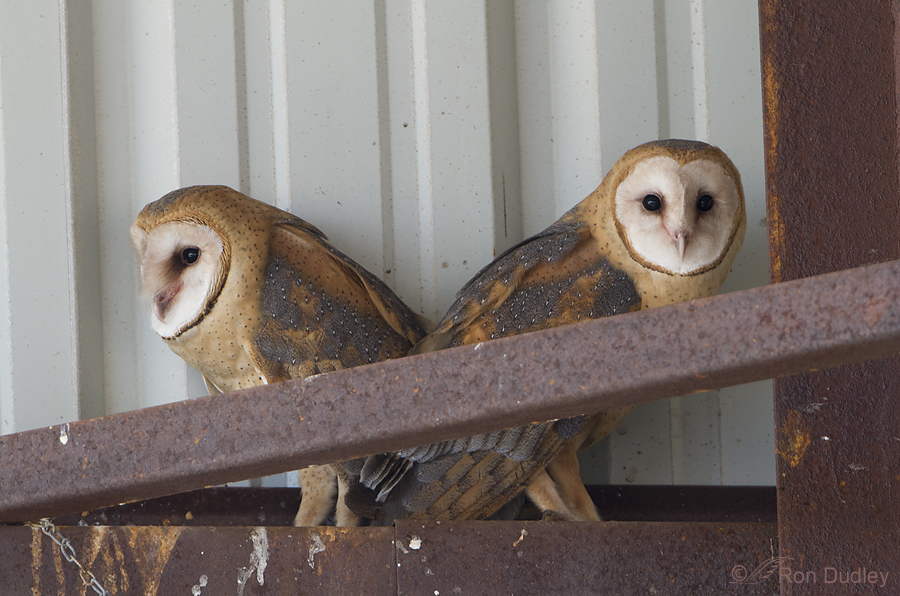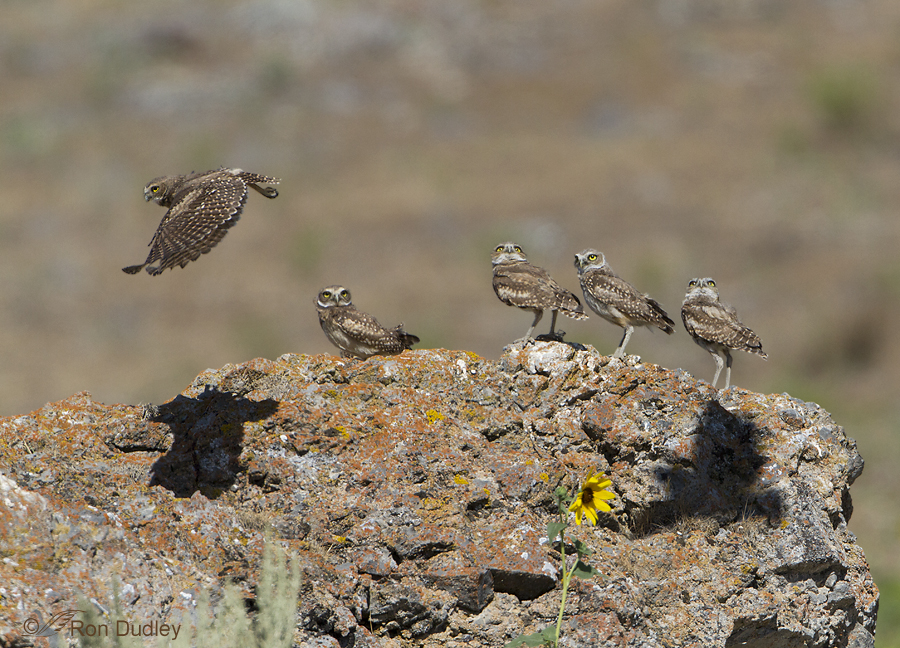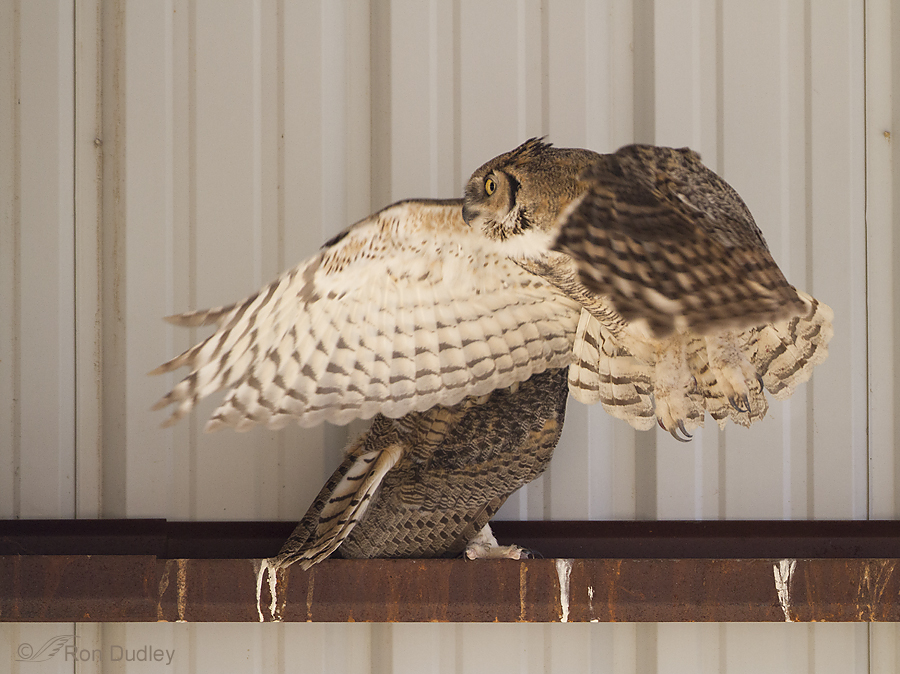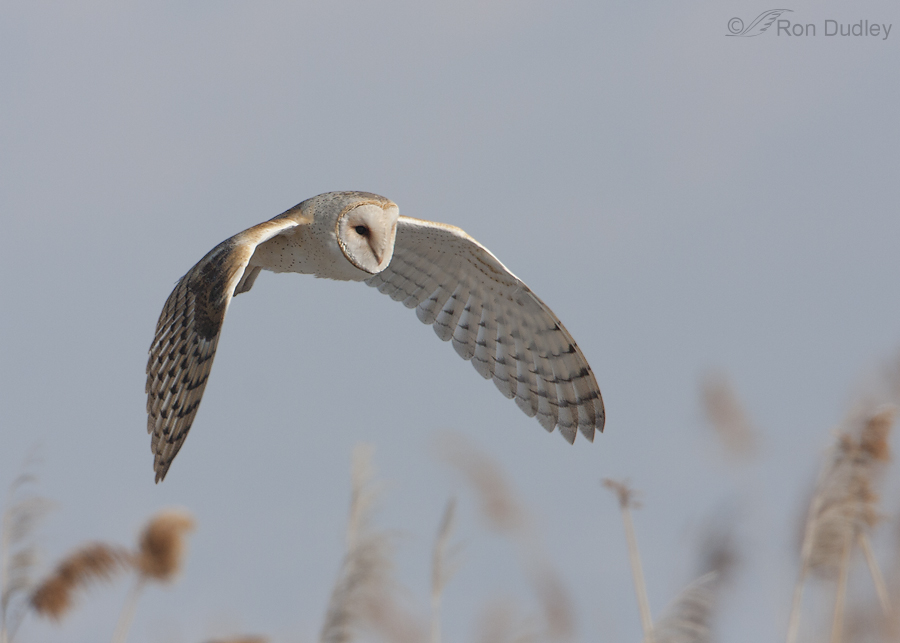Category: Owls
A Wet, Winking Great Horned Owl Fledgling
I love the half-closed, fuzzy eyelid and the ear tufts or “horns” that are just beginning to form on this young owl.
Some Hope For Barn Owls

I’ve reported previously on this blog that Barn Owl populations took a huge hit this past winter in northern Utah. It was dreadfully cold for much of the winter with lots of snow. Normally that’s not a huge problem for these owls but with deep snow on the ground we had a warm spell that melted the surface of the snow and immediately after that we had an extended cold snap. Those conditions caused a hard crust of ice to form on the snow surface that lasted for weeks.
Great Horned Owls In A Hay Barn
Barn Owl Update
A Glimmer Of Hope For Our Barn Owls
I heard some very good news on the Barn Owl front recently. Hawkwatch International reports that a pair of Barn Owls has taken up residence in one of the kestrel nest boxes that HI keeps an eye on and they have laid 5 eggs!
Short-eared Owl In Flight With Prey
This sequence is from the summer of 2010 in southwest Montana. The adult male was kept busy hunting and delivering voles to his family of two chicks and the female on the nest.
Burrowing Owl Youngsters – Hams Of The Bird World
Prepare to lose your heart if you ever have the opportunity to photograph or watch juvenile Burrowing Owls up close. They’re full of spontaneous antics and personality and they’re cute as a button.
Barn Owl In Flight Showing Dorsal Plumage Patterns and Alulae
Barn Owls have rather intricate plumage patterns and interesting color gradations on their dorsal (back) surfaces but they are rarely seen in their entirety in a single image. That’s partly because to get such an image you need to get them in flight with their wings out and tail spread which is very difficult to do since they’re primarily nocturnal. And when you do manage a flight shot of one you’re usually looking up at them and can’t see much, if any, of the dorsal surface. I thought this image fit the bill. especially with the bird looking down so that we can also see the colors and patterns on the top of the head. Yes, I do wish I had more light in the eye… 1/1600. f/8, ISO 500 500 f/4, 1.4 tc, natural light, canvas added for composition, not baited, set up or called in Another thing I like about the image is the clear look at the alulae (plural of alula) or “bastard wings – the first digit or “thumb” on the leading edge of the wing. And this shot shows one more thing that intrigues me – the right alula (left in our view) is extended further forward and at a sharper angle than the one on the birds left, perhaps in compensation for the tipped angle of flight. My research indicates that there’s still debate among experts about whether or not birds have muscular control of the alulae or they only respond to the pressure of air currents. This owl has just spotted potential prey below and is flying very slowly as…
A Close Encounter With A Short-eared Owl
This was a day I’m sure I’ll never forget – my first up close experience with an owl of any species in the wild. I’d only been photographing birds for about a year and I still had a lot to learn – about my gear, about technique and about my avian subjects.
Fighting Male Short-eared Owls
I’ve posted once before about the fighting Male Short-eared Owls I photographed in south-west Montana but I spent several days with these sparring birds and thought they deserved some more attention on my blog.
Short-eared Owl With Prey, Coming At Me
I’m always happy when I can get decent images of an owl in flight. If they’re carrying prey it’s a bonus. And if the bird is flying toward me I often consider it icing on the cake – partly because those kinds of shots are so very often baited, decoyed, set up or called in. As always for me, these were not. I’ve posted one of these shots before but I hoped it might be interesting for some to see a sequence of images as this adult male Short-eared Owl flew toward me with a vole for its mate before veering off to my right. 1/1000, f/5.6, ISO 800, 500 f/4, 1.4 tc, natural light, not baited, set up or called in This first image shows less detail and image quality because the owl was further away as it began to approach me but I decided to include it for context in the sequence. The lower background is sagebrush flats while the upper blues are Montana’s Centennial Mountains in shade. 1/1250, f/5.6, ISO 800, 500 f/4, 1.4 tc, natural light, not baited, set up or called in Four frames later the owl was significantly closer and flew almost directly at me before veering off – a pattern it followed more than once. I’d guess that it was his way of checking me out for any potential threat before delivering the vole. 1/1000, f/5.6, ISO 800, 500 f/4, 1.4 tc, natural light, not baited, set up or called in Which he’s doing intently here. Eye contact can’t be much…
Barn Owl In Flight Among The Phragmites
It’s funny sometimes, what inspires my next blog post. In this case it was an unexpected and very kind and thoughtful email from one of my readers who is a huge fan of Barn Owls in natural settings. Thank you for the inspiration, Donna!
Juvenile Burrowing Owl Posing Up A Storm
The antics of Burrowing Owls are always entertaining but “personality” simply oozes out of the juveniles. 1/400, f/8, ISO 500, 500 f/4, 1.4 tc, natural light, not baited, set up or called in This youngster had recently fledged and had begun to do a little exploring. On this early morning I found it on this perch just after sunrise. Thus was further away from the burrow than I’d seen any of the juveniles up to that point. 1/400, f/8, ISO 500, 500 f/4, 1.4 tc, natural light, not baited, set up or called in Within just a few minutes it gave me a variety of interesting poses – first an enthusiastic yawn… 1/500, f/8, ISO 500, 500 f/4, 1.4 tc, natural light, not baited, set up or called in and then long and drawn out wing stretch with left foot extended… 1/500, f/8, ISO 500, 500 f/4, 1.4 tc, natural light, not baited, set up or called in which concluded with the wing down and partially hidden behind the rock. Soon after this shot was taken the bird flew back to the comfort and security of the burrow and the rest of its family. Ron
Great Horned Owl Framed By Tamarisk
Typically when I find a Great Horned Owl in a natural setting it’s so deeply buried in the tree or foliage that it can barely be seen. This is a deliberate behavior, at least in part to avoid mobbing birds of many species. Crows, for example, will invariably mob an exposed GHO, pursuing it from tree to tree and calling out to other crows to recruit them to join in. 1/800, f/8, ISO 500, 500 f/4, 1.4 tc, natural light, not baited, set up or called in This owl, and one other, perched in the tamarisk for about a week but on most days they were virtually impossible to see unless you knew where to look. But on two cold, early mornings I found one of them in this spot where it was exposed to the warming rays of the sun. Its breast and belly feathers are wet, as are the drooping ear tufts. These birds sleep during much of the day but their slumber is light and alert as evidenced by their ear tuft (“horn”) movements in response to any slight sound, even with eyes closed – a behavior that’s interesting to observe if you’re lucky enough to be sufficiently close to a sleeping owl. Ron




